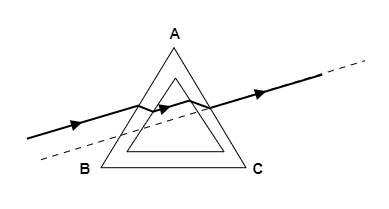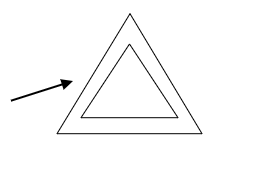
Answer
450.9k+ views
Hint:Dispersion refers to the splitting of white light into its component colours as it passes through a glass prism. Deviation refers to the difference in the angle of the emerging ray from the angle at which the light was incident on the glass prism. Here the light ray will undergo refraction as it enters and leaves the sides of the hollow glass prism.
Complete step by step answer.
Step 1: Sketch a figure describing how the ray of incident light emerges out of the hollow glass prism.
The hollow glass prism can be considered to be made of three glass slabs which are arranged to form an isosceles triangle ABC. This is shown in the figure below.

So when a ray of light is incident on the side AB, it will undergo refraction and bend towards the normal as it enters the side AB. As it leaves the side AB, it will bend away from the normal and will be incident on the side AC at the same angle at which the light was incident on AB. Just as in AB, the light ray will undergo refraction while entering and exiting the side AC. The ray emerging out of AC will be parallel to the incident ray and so the angle of deviation will be zero. This is shown in the figure given below.

Thus the light ray does not undergo dispersion or deviation.
So the correct option is D.
Note:Deviation only happens when the surface into which the light enters and the surface out of which the light exits are not parallel to each other. Refraction of a light ray does not ensure the deviation of the light ray. Light entering a denser medium will bend towards the normal and light leaving the denser medium to enter a rarer medium will bend away from the normal. Here when the light ray enters sides AB and AC it enters the denser medium of glass and as light leaves these sides it enters the rarer medium of air.
Complete step by step answer.
Step 1: Sketch a figure describing how the ray of incident light emerges out of the hollow glass prism.
The hollow glass prism can be considered to be made of three glass slabs which are arranged to form an isosceles triangle ABC. This is shown in the figure below.

So when a ray of light is incident on the side AB, it will undergo refraction and bend towards the normal as it enters the side AB. As it leaves the side AB, it will bend away from the normal and will be incident on the side AC at the same angle at which the light was incident on AB. Just as in AB, the light ray will undergo refraction while entering and exiting the side AC. The ray emerging out of AC will be parallel to the incident ray and so the angle of deviation will be zero. This is shown in the figure given below.

Thus the light ray does not undergo dispersion or deviation.
So the correct option is D.
Note:Deviation only happens when the surface into which the light enters and the surface out of which the light exits are not parallel to each other. Refraction of a light ray does not ensure the deviation of the light ray. Light entering a denser medium will bend towards the normal and light leaving the denser medium to enter a rarer medium will bend away from the normal. Here when the light ray enters sides AB and AC it enters the denser medium of glass and as light leaves these sides it enters the rarer medium of air.
Recently Updated Pages
Fill in the blanks with suitable prepositions Break class 10 english CBSE

Fill in the blanks with suitable articles Tribune is class 10 english CBSE

Rearrange the following words and phrases to form a class 10 english CBSE

Select the opposite of the given word Permit aGive class 10 english CBSE

Fill in the blank with the most appropriate option class 10 english CBSE

Some places have oneline notices Which option is a class 10 english CBSE

Trending doubts
Fill the blanks with the suitable prepositions 1 The class 9 english CBSE

How do you graph the function fx 4x class 9 maths CBSE

When was Karauli Praja Mandal established 11934 21936 class 10 social science CBSE

Which are the Top 10 Largest Countries of the World?

What is the definite integral of zero a constant b class 12 maths CBSE

Why is steel more elastic than rubber class 11 physics CBSE

Distinguish between the following Ferrous and nonferrous class 9 social science CBSE

The Equation xxx + 2 is Satisfied when x is Equal to Class 10 Maths

Differentiate between homogeneous and heterogeneous class 12 chemistry CBSE





